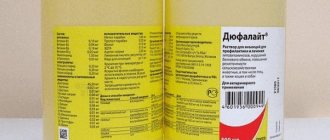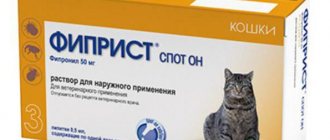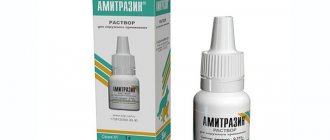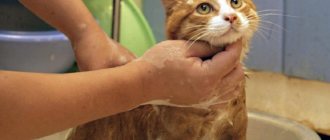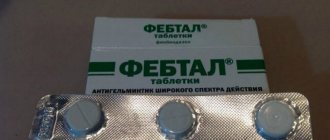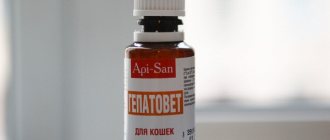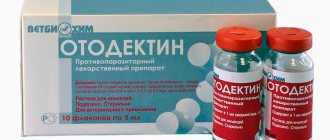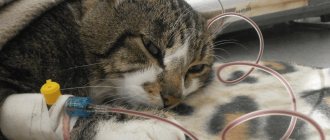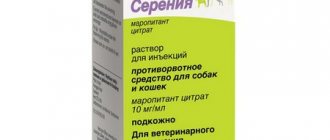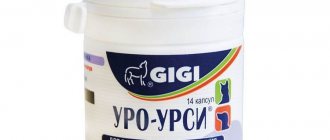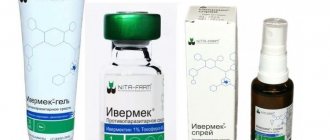3592Pavel
Instructions for using Ligfol for cats are of interest to many owners, since this immunomodulator is often prescribed to animals in a variety of cases. The product has already become firmly established in veterinary practice and has proven itself to be highly effective. The drug does not have toxic properties and is compatible even with strong drugs that significantly burden the body.
Cats almost always tolerate these injections very well. A veterinarian can prescribe Ligfol both in case of oncology in an animal and in stressful situations when the cat’s body requires maximum support.
© shutterstock
The drug is produced in the form of an injection liquid, which has a dark brown color. The composition has a very weak specific smell. Ligfol is produced in bottles for use in veterinary clinics in packaging from 100 to 500 ml or in ampoules with a volume of 1 to 5 ml. When treating an animal at home, ampoules are used, since each is designed for 1 injection.
general description
The drug is produced in the form of an injection solution. Although the instructions indicate that the drug can be injected and used for irrigation and washing of wounds. Externally, Ligfol is a transparent brown liquid (the presence of a dark brown tint is allowed). The medicinal liquid is packaged in transparent glass bottles of 1 and 100 ml. Purchasing large bottles for cats is usually impractical. They are intended for farm animals. Bottles of 1 ml are packed in 4 pieces in plastic cases, and only then in a cardboard box. In pharmacies, containers are sold individually, so it is not necessary to buy a whole package.
The main feature of the drug is that it contains humic substances. They are obtained as a result of a chemical reaction from wood fibers. The composition also includes the following components:
- sodium chloride;
- sodium pyrophosphate decahydrate;
- demineralized water.
Note! To prevent the medication from losing its unique medicinal properties, it must be stored in a dark place at a temperature of 10 to 25 degrees Celsius.
Composition and release form
The main components of the drug are humic substances obtained from wood hydrolytic lignin. It stimulates the immune system and provides antioxidant protection to the cat’s body. Auxiliary ingredients include sodium chloride, demineralized water and sodium pyrophosphate decahydrate.
Ligfol is a powerful immunomodulator of the latest generation.
Ligfol is a dark brown injection liquid with a slight specific odor. Available in the form of dark glass bottles of 100, 250 and 500 ml. More often you can find them on sale packaged in 4 pcs. in polymer packaging, glass ampoules with a capacity of 1 and 5 ml.
Operating principle and properties
Ligfol has a fairly wide spectrum of action, as it affects different systems and organs. It is able to activate immunity at the cellular level, stimulate the synthesis of interferon, due to which the animal’s body becomes resistant to viruses, bacteria and fungi. The components of the drug are involved in the formation of active oxygen and blood cells.
The innovative drug has the following effects on the body:
- strengthens and restores immunity after immunodeficiency and various diseases;
- stimulates tissue regeneration;
- normalizes liver function;
- removes toxic substances from the body;
- has a positive effect on metabolic processes;
- improves the functioning of the reproductive system;
- increases vitality in old animals.
The drug has pronounced antitumor properties, so it is often used in complex therapy for oncology.
Ligfol is a low-hazard substance. It has no toxic or embryotoxic effects, does not cause allergic reactions or addiction.
Composition of the drug
Ligfolum is a new generation complex veterinary drug based on natural raw materials. Belongs to the category of immomodulators, adaptogens, stress correctors. It has a gradual therapeutic effect after penetration into the bloodstream.
Important! Ligfol has antitumor and antioxidant effects, so the veterinary drug is used in complex therapy in combination with other antitumor agents.
Composition of the drug ligofol:
- Humic substances (6 mg). They are obtained by hydrolysis of wood lignin. Wood lignin is a high-molecular substance that is the basis of all plant fibers.
- Sodium pyrophosphate decahydrate.
- Demineralized water.
- Sodium chloride (3.0 mg).
- Sodium diphosphate (5.5 mg).
The composition of the drug is absolutely harmless to the body of warm-blooded animals, since ligfol consists entirely of natural ingredients.
Indications for use
The range of uses of the drug for cats, as well as other animals, is quite extensive. It is included in complex therapy in the treatment of the following pathologies:
- for diseases of the liver and pancreas;
- for infections caused by viruses and bacteria;
- for poisoning and toxicosis;
- when infected with ectoparasites (ticks, fleas, lice eaters);
- for helminthic infestations;
- for fungal diseases;
- in oncology.
The drug is also used to strengthen the immune system, prevent infectious and other diseases, and generally improve the pet’s health. The medication is also used to improve the functioning of the reproductive system in order to get healthy offspring. Ligfol can be used for kittens that are developmentally delayed and old animals to improve their vitality and health.
Since the components of the medicine improve regenerative processes, it is used in the following cases:
- after surgery:
- for fractures;
- with lacerations;
- for burns;
- with frostbite;
- with trophic ulcers;
- for purulent inflammation, etc.
Ligfol can also be used as a stress corrector to prevent negative reactions of the body to stressful situations. It is recommended to use it in the following situations:
- during transportation;
- when moving;
- when visiting a veterinary clinic;
- upon departure of the owner;
- when guests arrive, etc.
The medicine is also used to enhance the body's response to vaccination. As a result of use, a more stable and long-lasting immunity against infectious diseases is formed.
Medicines with similar effects - table
| Name | Release form | Active ingredient | Indications | Contraindications | Negative reactions | Can it be used to treat pregnant cats? | Price |
| Gamavit | Injection |
| It is used for immunodeficiency conditions, in the postoperative and postpartum periods. | None. | An allergy that is accompanied by itching and skin rashes. | Yes. | From 130 rub. |
| Emicidin | 2-ethyl-6-methyl-3-hydroxypyridine succinate | Prescribed to restore the functioning of the immune system, as well as for cardiac and inflammatory pathologies. | Individual intolerance to the composition. | Allergic reactions in the form of itching, burning and urticaria. | With doctor's permission. | From 195 rub. | |
| Ribotan | Low molecular weight peptides and RNA fragments | Used for the treatment and prevention of diseases caused by a decrease in the functioning of the body's defenses. | None. | None. | Yes. | From 900 rub. |
Medicines similar in mechanism of action - photo gallery
Emicidin prevents oxygen starvation of tissues Ribotan stimulates the immune system
Gamavit can be used in the postoperative period
How to use
According to the instructions for use, the dose of Ligfol for cats is calculated simply - for each kilogram of weight you need to take 0.1 ml of solution. But the regimen of use may differ depending on whether the drug is used for treatment or prevention. Injections are given intramuscularly.
The most commonly used application schemes are:
- To increase immunity in case of infectious diseases, make 2 infections with an interval of 2 days. If necessary, another 2-3 injections are given, but every 5 days.
- If your pet has chemical or food poisoning, injections are given every 3 days. Usually 3 injections are enough, but the number of procedures can be changed by the veterinarian.
- If worms are detected, the drug is injected 2-3 days before deworming, and then on the day of deworming. In order for a cat to quickly cope with intoxication that can occur as a result of deworming, another 2-3 injections are given with an interval of 5 days.
- To prevent possible unpleasant consequences of stress, a Ligfol injection is given 1-2 days before an event that can provoke changes. During long-term transportation, the medicine should be injected every 2 days.
- For benign tumors, the course consists of 6-8 injections. They need to be done once a week. Depending on the condition of the animal, the course is repeated after 2-3 months. For malignant tumors, injections of the drug are given every 3 days. Depending on the course of the disease, 5 to 10 injections may be needed. The course is repeated several times a year. After chemotherapy and surgery, Ligfol helps the animal recover faster.
To prevent complications after surgery and speed up the rehabilitation process, the drug can be used as injections or for local treatment. It is recommended to give an injection a few days before the operation, and then inject the medicine 1-2 more times after the intervention with an interval of 1-2 days. You can also treat the seams with a solution 1-4 times a day. When irrigated, the medication is diluted in equal proportions with water for injection. The procedures are repeated until the wounds begin to heal. If the integrity of the skin is damaged (burns, wounds, trophic ulcers, etc.), external use can also be combined with injections.
Note! It is advisable that the regimen for using Ligfol is calculated by a veterinarian. He will take into account the individual characteristics of the animal, the course of the disease and other factors.
Safety and personal hygiene measures
When giving injections to an animal, you must follow safety precautions so as not to harm the animal and yourself:
1. Wash your hands before the procedure.
2. Use only sterile disposable syringes.
3. Observe the storage conditions of the drug.
4. If Ligfol gets on human skin, rinse with plenty of water.
5. Properly hold the animal so that it does not bite or scratch. This requires two people - one holds the cat by the withers or the dog by the collar, the second stabs.
Did you know? Caring for animal health
—
the phenomenon is far from new. The famous Avicenna, for example, among other things, also wrote a treatise “On Animal Diseases”.
Contraindications and side effects
The instructions indicate that there are no contraindications for the use of Ligfol, so it can be used for cats of any age and breed. The drug is suitable for small kittens and old pets, pregnant and lactating females.
Injections of the medicine may be painful. Unpleasant sensations disappear within 5-10 minutes after the injection. There is no need to take special measures. The medication has no other side effects.
Instructions for use of Ligfol
Instructions for use of Ligfol come in the package, so before using the medicine, be sure to read the instructions, which indicate dosages, indications, and methods of use.
Ligfol is combined with various medications for symptomatic, complex therapy, as well as feed, nutritional supplements, and vitamins.
When working with the drug, follow the rules of personal hygiene, rules for working with medications, and do not violate safety precautions.
Owner reviews
Oksana, owner of a 15-year-old cat:
“Our cat was diagnosed with a tumor on her tongue. Ligfol was used for treatment (as prescribed by a doctor). The animal's condition improved noticeably after a week of treatment. The cat even tried to eat on her own. The drug significantly extended our girl’s life. The doctor noted that if the cat had been younger, there would have been a chance of a full recovery.”
Lyudmila, Maine Coon owner:
“At the age of 17, our cat was diagnosed with cancer. The Marquis was fading away right before our eyes. The doctors threw up their hands and told me to decide to euthanize. In one of the clinics, a female veterinarian recommended Ligfol. After the injections, the cat felt noticeably better and became more active. He lived another 2 months and then died. The disease was at the last stage, so there was no chance of recovery, but I am grateful to the drug that it gave our cat another 2 months of life.”
We treated our two cats with it. It's all in the review.
The veterinary drug Ligfol had to be used on two of our cats. Unfortunately, sores do not spare anyone; I was already quite old. Both cats had different problems.
The veterinarian prescribed this immunomodulator to the first cat for oncology, until the end of her days.
For the second cat - for treatment of the pancreas.
I will say this: the drug did not help in any case. Only for a while does the animal seem to revive, and then loses its strength altogether.
Our cat, who had problems with her pancreas for the first week, perked up very much, and then the vomiting became even worse. When the ligfol was cancelled, the cat even somehow perked up. Accordingly, the treatment was complex.
Well, of course, it didn’t help the first cat’s cancer. This drug is prescribed by veterinarians out of desperation “to keep the pants up” in order to somehow calm the owner down.
I will add that this drug is not cheap, and besides, the injections are very painful for the animal. You need to inject into the back leg, intramuscularly. This is another torment for the animal.
Of course, Ligfol’s indications are quite extensive; perhaps in mild cases it helps the animal gain strength. But in my review I cannot boast of such an effect.
The drug Ligfol has a wide range of applications and is therefore prescribed for a number of diseases. The medication improves the condition of cats with a variety of infectious pathologies, allowing them to recover faster. Despite the large number of advantages, it is recommended to read the instructions before starting treatment.
Precautions and special instructions
What precautions should you take:
- When administering the injection, carefully secure the cat, since if the needle gets into the nerve ending, the animal will limp for some time.
- Before giving your pet an injection, wear gloves.
- Alternate limbs, injecting the solution into different thighs each time, otherwise an infiltrate may form.
- Do not forcefully insert the needle.
- Do not treat the injection site with alcohol-containing solutions.
- Irrigate wounds with a new syringe each time, otherwise you may get an infection.
For injections, it is important to use only disposable syringes
It is important to note that the drug cannot be used to treat skin lesions of unknown etiology. You should definitely consult your doctor before starting treatment. Do not use an undiluted solution to irrigate ulcers, as this may cause pain.
Attention! If the pet’s condition worsens during treatment with Ligfol, it is recommended to cancel the injections and be sure to contact a veterinarian.
Storage conditions and precautions.
The most important thing you need to know: the solution is not intended for oral administration. There is no need to give it to your cat, children or drink it yourself. “Ligfol” is stored in a dark place, away from the eyes of children, cats, and dogs. They will find it, try it, then problems will arise. The drug lasted for the prescribed two years, was of no use and went to its well-deserved rest in the trash can. If you had to open a capsule or bottle, then after a day you need to say goodbye to it.
A task for owners with one unknown: how much will it cost to treat a tabby with “Ligfol”, provided that the injections are given at home. Answer: Ampoules with a volume of 1 ml are sold in packs of 4 pieces. The price of one ampoule is 150 rubles. Packaging price - 600 rubles. Larger bottles cost from 1,500 to 2,000 rubles. And these are indicative prices. It all depends on the region in which the owner lives and the price categories there.
